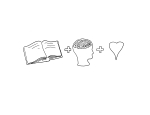This project began with an experiment among a small group, expanded to our school, and then spread beyond it. After our small experiment, the project centered around a package that we sent to teachers both at our school and beyond. What follows is a detailed description of the various stages and the contents of the packages we prepared.
—–
Inspired by the work of W. Glenn Griffin and Deborah Morrison, we ran this project in multiple stages. First, we tested it among ourselves, a small group of five. Then, we revised the prompt and materials when we ran it at our own school, with a teaching faculty of 80-100 teachers. Finally, we tweaked the project one more time and mailed it out to teachers across the country. Below is a version of the prompts and materials we used–a version that might prove useful to you if you’d like to replicate this at your school.
We mailed the project in a large, brown envelope made of stiff cardboard (12″ x 18″). It contained the following components:
- cover letter
- recommended instructions
- sample responses
- 11″ x 17″ 100lb paper (two sheets)
- double-tipped sharpie
In our school, we chose to leave the envelopes on teachers’ desks, like gifts, carefully packaged. We thought there would be more interest if we assembled them in this way, rather than filling mailboxes in a mailroom. We expected a return rate of 10-30%, and about 1 in 5 (20%) responded to the prompt. The details of the enclosed documents are below.
Cover Letter:
Dear _________,
In the course of our work as young teachers, we’ve engaged in discussions about how teachers plan and prepare for class. In our short time so far, we have found teaching to be extraordinarily creative work. We create every day: questions, assignments, lessons, experiences, classroom environments, and much more. Since people work in different ways, we’re studying the planning process by looking at how others do it. Our hope is to survey a wide range of responses and see what commonalities emerge.
We’re reaching out to you, our colleagues, because we admire your teaching. But rather than ask for a detailed explanation of how you plan your classes, we invite you to illustrate your preparation process on one sheet of paper. In our sample work, we have found that illustration promotes more conceptual and less prescriptive thinking. How will you capture the essence of your planning process on one page?
We’ve thought about this question in many ways. What drives our planning and preparation process? How much time do we spend planning for class? How do we spend that time? What do we think about? What are our goals and priorities? When we sit down to design our classes, what do we do?
Enclosed are several sample responses (our first efforts) and three simple tools:
- a new sharpie
- several blank 11” x 17” canvases
We would be grateful if you would take a short moment to share with us how you do what you do. Please find suggested instructions enclosed. We would love to gather these together by _____________, so that we may share the collected results back with you at the end of the year.
In gratitude, we’ll see if we can negotiate raises for everyone who participates… That’s likely… right…? (Thank you again!)
Best wishes,
(Names)
Recommended Instructions:
[Note: these instructions adapt language from W. Glenn Griffin and Deborah Morrison]
Instructions:
- Think about your own planning and preparation process. Think about the path you take when building daily experiences for your students.
- Experiment with illustrating that process on a scratch piece of paper. Can your visualization (with or without words) offer someone else an understanding of the process as you experience it?
- When you are satisfied with your solution, sketch your response in pencil on an enclosed 11 x 17 sheet, then use the Sharpie marker (provided) to finalize it.
- Place this sheet back in the envelope and leave the envelope in the box in the mailroom. Thank you for your participation!
Sample Responses:
We affixed a packet of eight sample responses to the instructions. We were intentional about creating a range of samples–some storyboards, some metaphorical approaches, some that focused on process, some that focused on values–so that teachers see a range of paths they might take. The images in the gallery below are the samples that we provided.
11″ x 17″ 100lb Paper
We used heavy paper–almost like matte cardboard–because it absorbed the sharpie marker quickly and would be less likely to warp from moisture. We included two sheets so that teachers could start over if they made a mistake.
Double-tipped sharpie
We placed bulk orders for these pens.











Pete, Katie, and Friends! The site looks so nice! Loved the fun package you sent me this summer. Sat on it for a bit and sent it back in July. You posted it in late July! Cool. Think my early summer pause got me on your “negligent” list, though, because you sent me a very nice “nudge” post-card in early October. I did it! I did it! Don’t waste more beautiful postcards on me (though I did really like getting Frank’s illustration in the mail). Thank you guys!
LikeLike